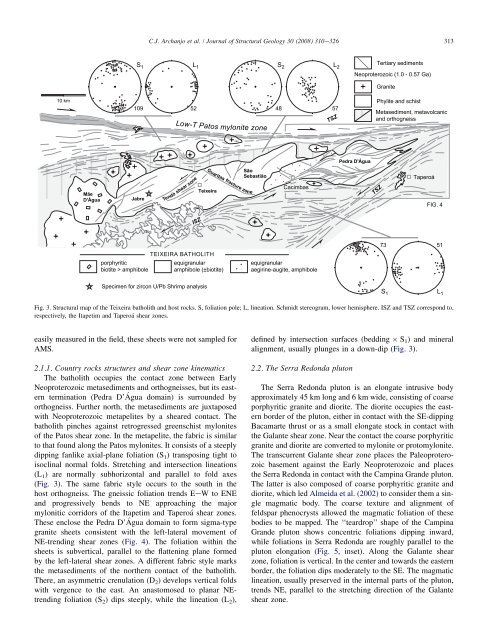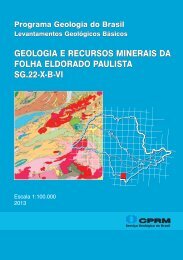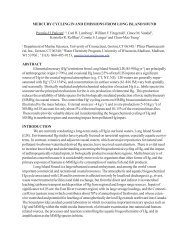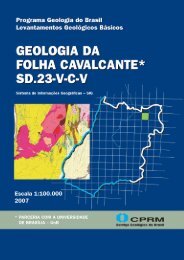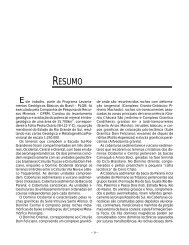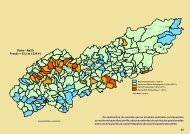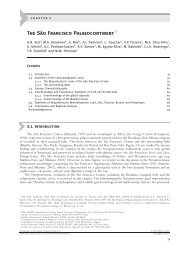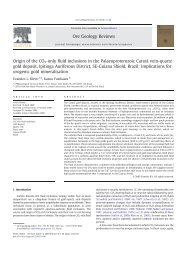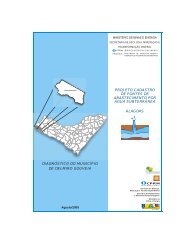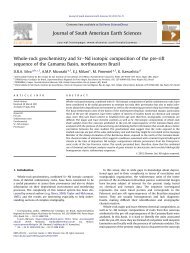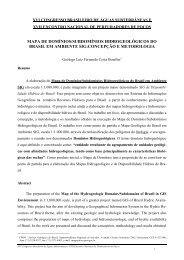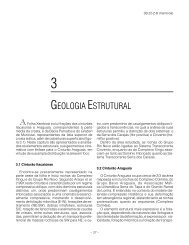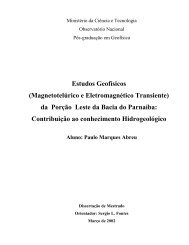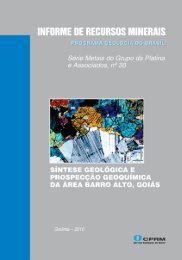Fabrics of pre- and syntectonic granite plutons and ... - CPRM
Fabrics of pre- and syntectonic granite plutons and ... - CPRM
Fabrics of pre- and syntectonic granite plutons and ... - CPRM
Create successful ePaper yourself
Turn your PDF publications into a flip-book with our unique Google optimized e-Paper software.
10 km<br />
Mãe<br />
D'Água<br />
S 1 L 1 S 2 L 2<br />
109 52 48 57<br />
Jabre<br />
porphyritic<br />
biotite > amphibole<br />
easily measured in the field, these sheets were not sampled for<br />
AMS.<br />
2.1.1. Country rocks structures <strong>and</strong> shear zone kinematics<br />
The batholith occupies the contact zone between Early<br />
Neoproterozoic metasediments <strong>and</strong> orthogneisses, but its eastern<br />
termination (Pedra D’Agua domain) is surrounded by<br />
orthogneiss. Further north, the metasediments are juxtaposed<br />
with Neoproterozoic metapelites by a sheared contact. The<br />
batholith pinches against retrogressed greenschist mylonites<br />
<strong>of</strong> the Patos shear zone. In the metapelite, the fabric is similar<br />
to that found along the Patos mylonites. It consists <strong>of</strong> a steeply<br />
dipping fanlike axial-plane foliation (S 1) transposing tight to<br />
isoclinal normal folds. Stretching <strong>and</strong> intersection lineations<br />
(L1) are normally subhorizontal <strong>and</strong> parallel to fold axes<br />
(Fig. 3). The same fabric style occurs to the south in the<br />
host orthogneiss. The gneissic foliation trends EeW to ENE<br />
<strong>and</strong> progressively bends to NE approaching the major<br />
mylonitic corridors <strong>of</strong> the Itapetim <strong>and</strong> Taperoá shear zones.<br />
These enclose the Pedra D’Agua domain to form sigma-type<br />
<strong>granite</strong> sheets consistent with the left-lateral movement <strong>of</strong><br />
NE-trending shear zones (Fig. 4). The foliation within the<br />
sheets is subvertical, parallel to the flattening plane formed<br />
by the left-lateral shear zones. A different fabric style marks<br />
the metasediments <strong>of</strong> the northern contact <strong>of</strong> the batholith.<br />
There, an asymmetric crenulation (D2) develops vertical folds<br />
with vergence to the east. An anastomosed to planar NEtrending<br />
foliation (S 2) dips steeply, while the lineation (L 2),<br />
C.J. Archanjo et al. / Journal <strong>of</strong> Structural Geology 30 (2008) 310e326<br />
Low-T Patos mylonite zone<br />
Teixeira<br />
Tendó shear zone Guaritas fracture zone<br />
ISZ<br />
TEIXEIRA BATHOLITH<br />
equigranular<br />
amphibole (±biotite)<br />
Specimen for zircon U/Pb Shrimp analysis<br />
São<br />
Sebastião<br />
Cacimbas<br />
equigranular<br />
aegirine-augite, amphibole<br />
TSZ<br />
defined by intersection surfaces (bedding S 1) <strong>and</strong> mineral<br />
alignment, usually plunges in a down-dip (Fig. 3).<br />
2.2. The Serra Redonda pluton<br />
Tertiary sediments<br />
Neoproterozoic (1.0 - 0.57 Ga)<br />
Pedra D'Água<br />
Granite<br />
Phylite <strong>and</strong> schist<br />
Metasediment, metavolcanic<br />
<strong>and</strong> orthogneiss<br />
Taperoá<br />
FIG. 4<br />
73 51<br />
Fig. 3. Structural map <strong>of</strong> the Teixeira batholith <strong>and</strong> host rocks. S, foliation pole; L, lineation. Schmidt stereogram, lower hemisphere. ISZ <strong>and</strong> TSZ correspond to,<br />
respectively, the Itapetim <strong>and</strong> Taperoá shear zones.<br />
The Serra Redonda pluton is an elongate intrusive body<br />
approximately 45 km long <strong>and</strong> 6 km wide, consisting <strong>of</strong> coarse<br />
porphyritic <strong>granite</strong> <strong>and</strong> diorite. The diorite occupies the eastern<br />
border <strong>of</strong> the pluton, either in contact with the SE-dipping<br />
Bacamarte thrust or as a small elongate stock in contact with<br />
the Galante shear zone. Near the contact the coarse porphyritic<br />
<strong>granite</strong> <strong>and</strong> diorite are converted to mylonite or protomylonite.<br />
The transcurrent Galante shear zone places the Paleoproterozoic<br />
basement against the Early Neoproterozoic <strong>and</strong> places<br />
the Serra Redonda in contact with the Campina Gr<strong>and</strong>e pluton.<br />
The latter is also composed <strong>of</strong> coarse porphyritic <strong>granite</strong> <strong>and</strong><br />
diorite, which led Almeida et al. (2002) to consider them a single<br />
magmatic body. The coarse texture <strong>and</strong> alignment <strong>of</strong><br />
feldspar phenocrysts allowed the magmatic foliation <strong>of</strong> these<br />
bodies to be mapped. The ‘‘teardrop’’ shape <strong>of</strong> the Campina<br />
Gr<strong>and</strong>e pluton shows concentric foliations dipping inward,<br />
while foliations in Serra Redonda are roughly parallel to the<br />
pluton elongation (Fig. 5, inset). Along the Galante shear<br />
zone, foliation is vertical. In the center <strong>and</strong> towards the eastern<br />
border, the foliation dips moderately to the SE. The magmatic<br />
lineation, usually <strong>pre</strong>served in the internal parts <strong>of</strong> the pluton,<br />
trends NE, parallel to the stretching direction <strong>of</strong> the Galante<br />
shear zone.<br />
TSZ<br />
S 1<br />
L 1<br />
313


